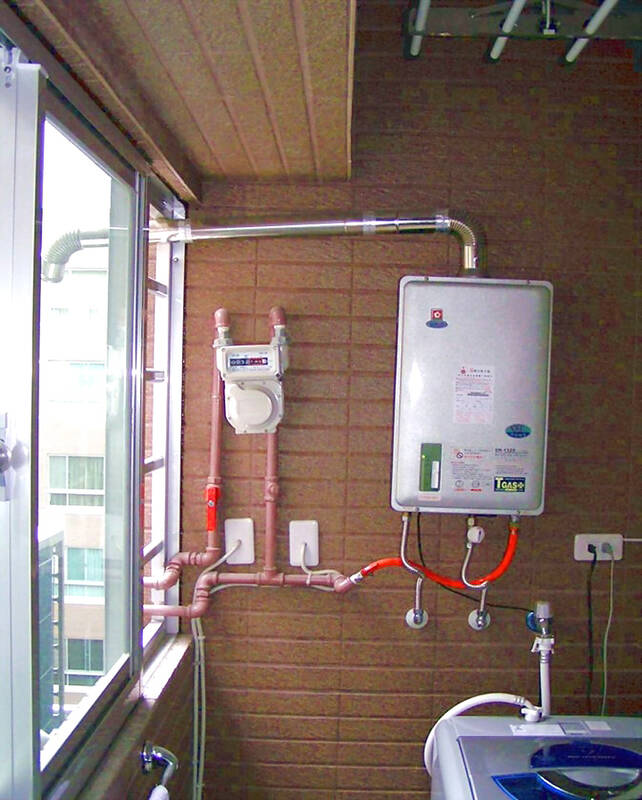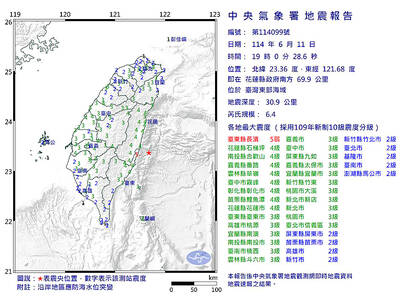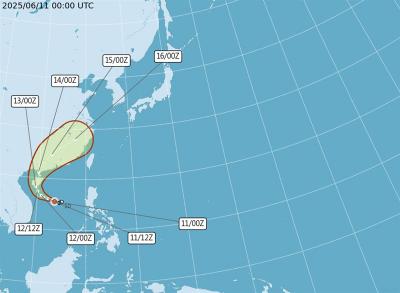Rooftop flue water heaters should only be installed outdoors or in properly ventilated areas to prevent toxic gas from building up, the Yilan County Fire Department said, after a man in Taipei died of carbon monoxide poisoning on Monday last week.
The 39-year-old man, surnamed Chen (陳), an assistant professor at Providence University in Taichung, was at his Taipei home for the holidays when the incident occurred, news reports said.
He was taking a shower in the bathroom of a rooftop addition when carbon monoxide — a poisonous byproduct of combustion — leaked from a water heater installed in a poorly ventilated space.

Photo: Taipei Times
Chen’s elder sister, who lived downstairs, found him lying in the bathroom, while the faucet was on.
A postmortem examination confirmed that he had died of carbon monoxide poisoning.
The Yilan County Fire Department said that carbon monoxide is an “invisible killer” at home, as the colorless, odorless gas is difficult to detect.
People who inhale carbon monoxide might feel fatigued or dizzy before losing consciousness and eventually dying, it said.
Rooftop flue-type gas water heaters, also known as outdoor water heaters, placed in poorly ventilated spaces tend to generate carbon monoxide, as the liquid petroleum gas or natural gas would burn incompletely due to insufficient oxygen, it said.
In Taiwan, gases are required to be treated with a mercaptan odorant to make leaks easier to detect, it said.
Carbon monoxide’s affinity for hemoglobin is 200 to 250 times greater than that of oxygen, meaning it would replace oxygen to bind to hemoglobin, forming carboxyhemoglobin, which reduces hemoglobin’s oxygen-carrying capacity, it said.
With not enough oxygen delivered to the tissues, symptoms of carbon monoxide poisoning would ensue, such as headaches, nausea or unconsciousness, the department said, adding that death occurs in serious cases.
People who experience dizziness, nausea, drowsiness or other symptoms of carbon monoxide poisoning while using a gas-fired water heater should turn the unit off immediately and open doors and windows to ventilate the area, it said.
They should call 119 if they feel seriously unwell, it added.
If a person believes someone is experiencing symptoms of carbon monoxide poisoning, they should also conduct cardiopulmonary resuscitation (CPR) after calling 119, it said.
Although paramedics would conduct CPR and oxygen therapy, correctly performed CPR administered immediately is indispensable in preventing hypoxia-induced brain death, the department said.
The proper installation of gas-fired water heaters can prevent the buildup of carbon monoxide, it said.
People should buy water heaters with a CNS certification mark and choose the appropriate type based on the ventilation capacity of the space in which it is to be installed, it said.
Rooftop flue-type water heaters should be installed only in places with good ventilation, such as outdoor environments, while forced exhaust-type water heaters or forced draught balanced flue-type water heaters are recommended for poorly ventilated areas or indoor environments, it said.
To maintain good ventilation, avoid installing additional doors, windows or rain shelters that would obstruct the area around a water heater, and avoid drying a lot of clothes around a water heater, even outdoors, it said.
A water heater should be installed by a qualified technician and be regularly inspected, it added.
Only a qualified technician should replace or move a water heater, or rearrange its ducts or pipes, it said.

A magnitude 6.4 earthquake struck off the coast of Hualien County in eastern Taiwan at 7pm yesterday, the Central Weather Administration (CWA) said. The epicenter of the temblor was at sea, about 69.9km south of Hualien County Hall, at a depth of 30.9km, it said. There were no immediate reports of damage resulting from the quake. The earthquake’s intensity, which gauges the actual effect of a temblor, was highest in Taitung County’s Changbin Township (長濱), where it measured 5 on Taiwan’s seven-tier intensity scale. The quake also measured an intensity of 4 in Hualien, Nantou, Chiayi, Yunlin, Changhua and Miaoli counties, as well as

Taiwan is to have nine extended holidays next year, led by a nine-day Lunar New Year break, the Cabinet announced yesterday. The nine-day Lunar New Year holiday next year matches the length of this year’s holiday, which featured six extended holidays. The increase in extended holidays is due to the Act on the Implementation of Commemorative and Festival Holidays (紀念日及節日實施條例), which was passed early last month with support from the opposition Chinese Nationalist Party (KMT) and Taiwan People’s Party. Under the new act, the day before Lunar New Year’s Eve is also a national holiday, and Labor Day would no longer be limited

COMMITMENTS: The company had a relatively low renewable ratio at 56 percent and did not have any goal to achieve 100 percent renewable energy, the report said Pegatron Corp ranked the lowest among five major final assembly suppliers in progressing toward Apple Inc’s commitment to be 100 percent carbon neutral by 2030, a Greenpeace East Asia report said yesterday. While Apple has set the goal of using 100 percent renewable energy across its entire business, supply chain and product lifecycle by 2030, carbon emissions from electronics manufacturing are rising globally due to increased energy consumption, it said. Given that carbon emissions from its supply chain accounted for more than half of its total emissions last year, Greenpeace East Asia evaluated the green transition performance of Apple’s five largest final

The first tropical storm of the year in the western North Pacific, Wutip (蝴蝶), has formed over the South China Sea and is expected to move toward Hainan Island off southern China, the Central Weather Administration (CWA) said today. The agency said a tropical depression over waters near the Paracel and Zhongsha islands strengthened into a tropical storm this morning. The storm had maximum sustained winds near its center of 64.8kph, with peak gusts reaching 90kph, it said. Winds at Beaufort scale level 7 — ranging from 50kph to 61.5kph — extended up to 80km from the center, it added. Forecaster Kuan Hsin-ping